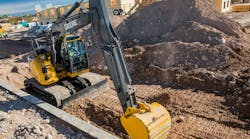“Dad, the genie lamp is on,” our son said when he called to say the car sounded funny. After replacing the engine, he understood that the “genie lamp” indicator means oil pressure, and, hence, the oil level is low. In his defense, we had forgotten to check the oil in recent weeks and had neglected to teach him the routine. After all, it was his parents’ car, so the ownership costs weren’t borne by the operator of the car.
Sound familiar? Most fleet managers have experienced the same, if more costly, scenario. An operator ignores or misunderstands an indicator light, which leads to an early or unnecessary machine repair. Many managers probably wish they could have real-time access to instrument panels so they could tell operators what to do when such things occur.
Telematics provide that real-time access to machines. Equipment-management personnel can receive alerts via fault codes when something is wrong with a piece of equipment outfitted with electronic monitors. Yet many turn off such alerts because many of them are inaccurate or because so many arrive that they cannot respond properly to the data overload.
This inconvenience, along with the inability to defend the return on technology investment, has prevented too many fleet managers from implementing a telematics strategy. Avoidance might have been all right three or five years ago; it’s not a viable strategy today.
Machine technology and telematics can be daunting. Manager must first educate themselves about it, but then they must be able to convincely educate their management teams about it. Most equipment managers recognize the potential for cost savings, but the scope of the situation overwhelms them.
Instead of swinging for the fences, perhaps managers would benefit from a few simple successes with their telematics opportunities:
- Track idle time. Show some serious savings in fuel costs.
- Track and monitor machines. Know what unit is where and how many hours it is working on each job site.
- Monitor fault codes. Drive preventive maintenance and uptime rates closer to 100 percent.
These are real savings; these are costs that can be reduced and reflected in equipment rates and bid rates. Upper management will see the results and become interested in other telematics benefits.
Fleet managers would be well advised to not become distracted or discouraged by trying to hit home runs with telematics data integration. Full-on back-end implementation will be difficult. Instead, aim for singles and doubles.
Even if it’s a base on balls, in order to score a run you need a runner on base.





